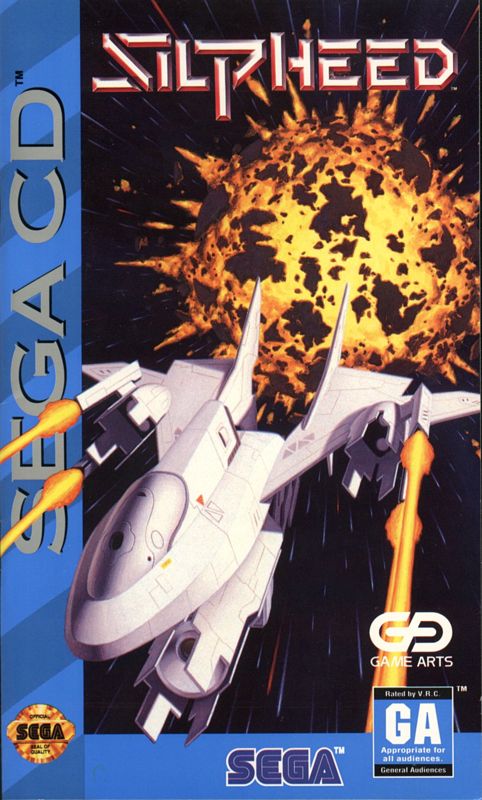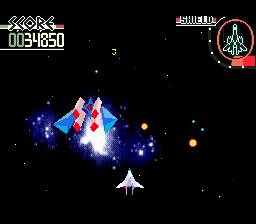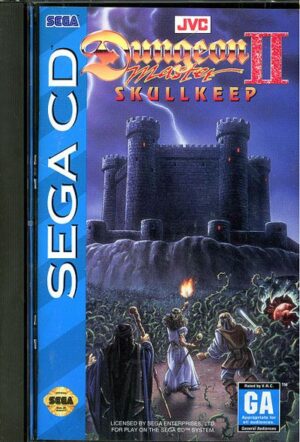Retro Replay Review
Gameplay
Silpheed offers a classic shoot-’em-up experience that feels both familiar and fresh on the Sega CD. At its core, you pilot a starfighter along a two-dimensional plane that extends into the screen, reminiscent of a pinball table’s depth. Enemy ships and projectiles cascade toward you against a backdrop of pre-rendered video, and your reflexes are put to the test as you weave, dodge, and unleash a barrage of firepower.
(HEY YOU!! We hope you enjoy! We try not to run ads. So basically, this is a very expensive hobby running this site. Please consider joining us for updates, forums, and more. Network w/ us to make some cash or friends while retro gaming, and you can win some free retro games for posting. Okay, carry on 👍)
The controls are straightforward yet precise: accelerate, decelerate, strafe, and fire primary and secondary weapons with ease. The secondary weapons—homing missiles, spread shots, and laser bombs—add a tactical layer, encouraging you to conserve special ammo for boss encounters or particularly dense waves. Item pick-ups float toward you in predictable patterns, rewarding careful positioning rather than frantic button-mashing.
Progression is broken into 11 stages, each raising the difficulty in measured increments. Early levels introduce basic fighters and asteroids, while later ones feature complex enemy formations and environmental hazards. Boss battles cap off each stage, challenging you to identify attack patterns and strike weak points on massive capital ships or orbital defense platforms.
The balance between risk and reward is well-tuned. You can stockpile secondary weapon icons for a brief power boost, but getting hit resets you to your baseline armament—making survival almost as valuable as raw firepower. While the linear stage structure can feel repetitive over extended play sessions, the tight level design and consistent pacing keep the action engaging from start to finish.
Graphics
On the Sega CD, Silpheed stands out for its innovative use of pre-rendered video backgrounds combined with filled-polygon sprites. The backdrops—ranging from starfields to planetary surfaces—are actually streamed video, giving the impression of smooth, cinematic movement that was rare for early ’90s console shooters. This technique elevates the sense of scale and depth far beyond typical 2D scrollers.
The player ship and enemies are rendered as flat-shaded polygons, which may look simple by modern standards but held their own in the era of sprite-based competition. Polygons rotate and scale smoothly, especially during boss encounters where massive vessels loom ominously. Explosions and laser beams pop with satisfying brightness against the muted video backgrounds.
Frame rate remains mostly steady, though you may notice occasional dips when the screen fills with enemies and projectiles. These slowdowns are infrequent and never jeopardize gameplay responsiveness. Color palettes shift subtly from level to level—icy blues for deep space, fiery reds near star cores—keeping the visuals from feeling stagnant.
Overall, the graphical presentation showcases the Sega CD’s unique capabilities. The combination of video backdrops and real-time polygon rendering feels like a bridge between 2D arcades and the burgeoning world of 3D gaming. For collectors and retro enthusiasts, Silpheed’s visuals remain an impressive artifact of early CD-ROM experimentation.
Story
The narrative in Silpheed is straightforward and archetypal: a malevolent force has hijacked the Galaxy Network’s central computer, and terrorists are unleashing orbital bombardment on defenseless colonies. You assume command of the Silpheed craft—the Galaxy Union’s last line of defense—and embark on a one-way mission across the stars to reclaim Earth and restore order.
Storytelling is conveyed primarily through brief text interludes between stages, accompanied by schematic renderings of your mission objectives. There’s no voiced dialogue or character development, but the urgency is palpable: each new mission briefing warns of escalating civilian casualties and the impending danger to humanity’s core worlds.
While the plot won’t win awards for originality, it serves its purpose in driving the action forward. The clear stakes and concise mission goals maintain momentum, ensuring you always know why you’re blasting through squadrons of enemy fighters rather than simply chasing a high score.
For players seeking deep lore or branching narratives, Silpheed may feel underwhelming. However, in the context of its genre and era, the story delivers just enough motivation to keep you invested from Stage 1 through the climactic showdown at Earth’s orbit.
Overall Experience
Silpheed on Sega CD remains a compelling package for fans of arcade-style shooters. Its seamless blend of 2D gameplay and 3D graphical effects—especially the video backdrops—was groundbreaking at release and still holds nostalgic appeal today. The straightforward control scheme and well-paced difficulty curve make it accessible to newcomers while offering enough challenge to keep veterans engaged.
Replay value stems from mastering each stage, maximizing secondary weapon usage, and chasing high scores. Speedrunners appreciate the tight stage layouts and the predictable enemy spawn patterns, which reward memorization and precise maneuvering. Collectors, meanwhile, will value Silpheed as one of the definitive showcase titles for the Sega CD add-on.
That said, modern players accustomed to deep progression systems and advanced graphics may find it dated. The lack of multiplayer or branching paths limits long-term variety, and repeated playthroughs can feel repetitive after the initial thrill fades. Still, for its historical importance and pure shoot-’em-up fun, Silpheed delivers a polished, entertaining ride.
In summary, Silpheed is a standout example of early CD-based gaming, marrying addictive gameplay with novel visual techniques. Whether you’re a retro enthusiast looking to experience a piece of gaming history or simply a shooter aficionado seeking a solid challenge, Silpheed is a worthy addition to your collection.
 Retro Replay Retro Replay gaming reviews, news, emulation, geek stuff and more!
Retro Replay Retro Replay gaming reviews, news, emulation, geek stuff and more!









Reviews
There are no reviews yet.